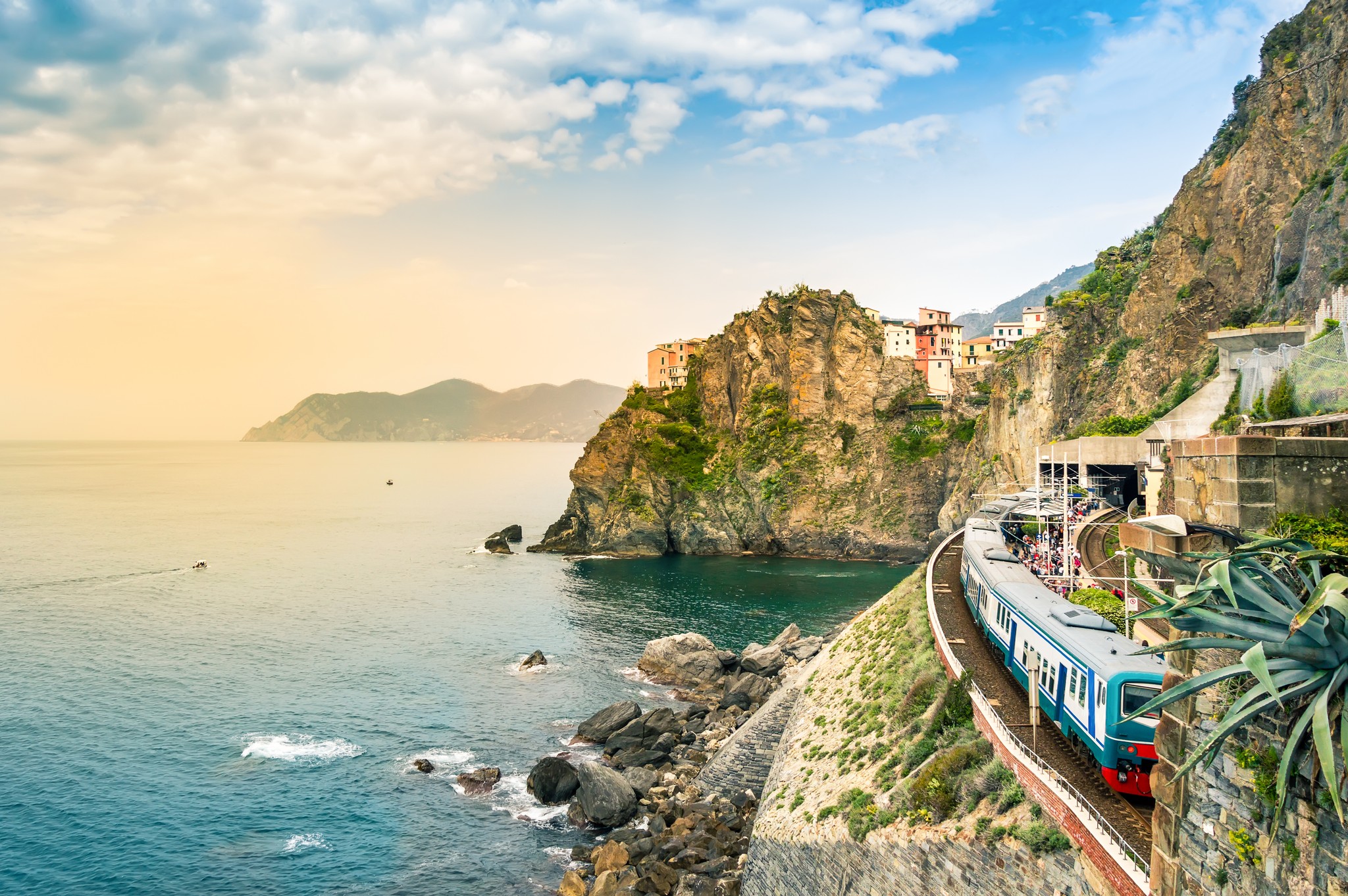From grand capitals to coastal villages, train travel links Europe with ease, comfort, and ever-changing views — all with a lighter footprint. This summer, let these five themed rail journeys inspire a slower, more scenic way to explore.
Mediterranean coastal explorer
The Med is calling! From Barcelona's urban beaches to the cliffs of the Amalfi Coast, this journey showcases the best of Spain, France, and Italy’s Mediterranean coastline. Along the way, savor regional cuisines — from Costa Brava's seafood and Marseille's signature bouillabaisse to the anchovies of Cinque Terre prepared with just lemon and olive oil.
Duration: 14–21 days
Countries: Spain, France, Italy

DroneTop/Shutterstock
Highlights and timing
Barcelona, Spain (2–3 days): Admire Gaudí's fantastical architecture at the Sagrada Familia and Park Güell, explore the narrow medieval streets of El Born, and unwind on Barceloneta’s lively urban beaches.
Train to Costa Brava: 1.5–2 hours, direct
Costa Brava and Figueres, Spain (1–2 days): Step into the surreal world of the Dalí Theatre-Museum with its egg-topped towers, then explore hidden coves and scenic trails along the rugged coastline.
Train to Marseille: 4–6 hours, direct or with connection
Marseille, France (2 days): Savor freshly caught seafood in the Old Port, hunt for treasures at the colorful Noailles market, and explore Calanques National Park.
Train to the French Riviera: 2–2.5 hours, direct
French Riviera, France (2–3 days): Lounge on glamorous beaches in Nice, stroll along Menton's lemon tree-lined promenades, and explore colorful hillside villages that have inspired countless artists.
Train to Genoa: 3–4 hours, direct or with connection
Genoa, Italy (1–2 days): Lose yourself in one of Europe's largest and most densely populated medieval centers, admire opulent palaces along the Strade Nuove, and indulge in fresh pesto in the city that invented it.
Train to La Spezia: 1–1.5 hours, direct
La Spezia (gateway to the Cinque Terre), Italy (2–3 days: Hike scenic trails connecting five pastel-colored villages perched on cliffs, visit hillside wineries producing sciacchetrà dessert wine, and feast on anchovies prepared the local way.
Train to Rome: 3.5–5 hours, direct or with connection
Rome, Italy (2–3 days): Marvel at Caravaggio's painted masterpieces in churches across the city, visit the famous Spanish Steps, and savor perfect pasta in traditional trattorias.
Train to Naples: 1–2 hours, direct
Naples and Amalfi Coast, Italy (2-3 days): Devour pizza in its birthplace, visit Pompeii to see an ancient Roman city preserved by one of history's most violent volcanic eruptions, and relax on scenic beaches along the Amalfi coast.
Optional extension: Sicily (add 3–4 days): Explore Europe's largest Mediterranean island with its ancient temples, vibrant cities, and distinctive cuisine.
Train + ferry to Sicily: 5–7 hours, with ferry connection
Insider tip: On the French TER trains between Marseille and Nice and Italian Intercity trains along the Ligurian coast, try to sit on the right side of the train when heading east and the left side when heading west for the best Mediterranean views.
Capital connections
Whether you’re cruising along Amsterdam's canals or unwinding in Budapest's thermal baths, this urban adventure links six distinctive European capitals. Experience Berlin's legendary nightlife, Prague's medieval squares, the imperial grandeur of Vienna, and Bratislava's compact castle district — all connected by an efficient network of high-speed and overnight trains. Pack your comfiest sneakers — there’s going to be a lot of walking.
Duration: 11–14 days
Countries: Netherlands, Germany, Czechia, Austria, Slovakia, Hungary

Yasonya/Shutterstock
Highlights and timing
Amsterdam, Netherlands (2–3 days): Cycle along picturesque canals, admire Van Gogh's masterpieces, and experience the traditional brown cafes in this laid-back capital.
Train to Berlin: 6–7 hours, direct train (overnight option available)
Berlin, Germany (2–3 days): Walk along the East Side Gallery (part of the Berlin Wall now decorated with impactful murals), experience the pulsing nightlife in world-renowned clubs, and relax in sprawling Tiergarten park.
Train to Prague: 4–5 hours, direct
Prague, Czechia (2 days): Cross the statue-lined Charles Bridge at dawn, explore the hilltop castle complex, and sip on pilsen lagers in old taverns.
Train to Vienna: 4 hours, direct
Vienna, Austria (2 days): Waltz through opulent palaces, indulge in sachertorte (chocolate cake) in traditional coffee houses, and catch a performance at the world-famous Vienna State Opera.
Train to Bratislava: 1 hour, direct
Bratislava, Slovakia (1 day): Climb the UFO Tower for panoramic Danube views, explore the compact Old Town and its whimsical statues, and sample hearty Slovak cuisine.
Train to Budapest: 2.5–4 hours, direct or with connection
Budapest, Hungary (2–3 days): Soak in historic thermal baths, cruise the Danube at sunset to see illuminated monuments, and dance till dawn in gritty ruin bars.
Insider tip: Many European capitals offer city passes (like the I Amsterdam Card, Berlin WelcomeCard, or Vienna Pass) which cover public transportation and entry to major attractions. These can save significant money if you plan to visit multiple museums and landmarks.
Historical rail pilgrimage
Trace the evolution of European civilization from Rome's ancient forums through Florence's Renaissance art, Switzerland's medieval old towns, the grand boulevards of Paris, and finally London's blend of history and modernity. This journey follows the development of art and architecture across the centuries. If you’re a history nerd, look no further.
Duration: 12–15 days
Countries: Italy, Switzerland, France, Belgium, UK

cacei.ro/Shutterstock
Highlights and timing
Rome, Italy (2–3 days): Step back in time at the Colosseum, admire frescoes at the Sistine Chapel, and see the Pantheon.
Train to Florence: 1.5 hours, direct
Florence, Italy (2 days): Gaze at Michelangelo's towering statue of David, climb Brunelleschi's dome for panoramic city views, and stroll across the medieval Ponte Vecchio.
Train to Bern: 5.5–7 hours, with connection
Bern, Switzerland (1–2 days): Wander through perfectly preserved medieval arcades, swim in the emerald-hued river Aare in summer, and visit Einstein's apartment where he developed his theory of relativity.
Train to Paris: 4.5–5 hours, with connection
Paris, France (2–3 days): Ascend the Eiffel Tower for sweeping city views, lose yourself in the Louvre’s vast collection of artworks, and linger over a coffee at sidewalk cafés in Le Marais.
Train to Bruges: 2.5–3 hours, with connection
Bruges, Belgium (1–2 days): Glide along tranquil canals on a boat tour, buy treats at artisanal chocolate shops, and climb the 366 steps of the Belfry tower for views over the medieval rooftops.
Train to London: 3.5 hours, with connection
London, UK (2–3 days): Explore an endless choice of museums with free entry, catch a West End show in the theater district, and walk along the River Thames.
Insider tip: Some European train stations are architectural gems worth admiring, like Paris Gare de l'Est and London St Pancras. These grand 19th-century terminals showcase stunning design elements and fascinating history: look up at Gare de l'Est to spot an 1855 mural depicting soldiers departing for the Crimean War.
Nordic nature and design
Outdoor enthusiasts, this one’s for you! From Copenhagen's colorful harbors and Stockholm's archipelago to the Arctic wilderness of northern Sweden and the Bergen Railway through Norway’s mountains, this Nordic adventure showcases Scandinavia's innovative urban design, wild landscapes, and endless summer days under the midnight sun.
Duration: 17–20 days
Countries: Denmark, Sweden, Norway

Nowaczyk/Shutterstock
Highlights and timing
Copenhagen, Denmark (2–3 days): Cycle through the bike-friendly city, sample street food in the bustling Torvehallerne market, and visit art and design museums like The Designmuseum Denmark.
Train to Malmö: 40 minutes, direct
Malmö, Sweden (1 day): Explore the twisting form of the Turning Torso skyscraper, picnic in the expansive Kungsparken, and browse contemporary Scandinavian design shops in the revitalized Western Harbor district.
Train to Stockholm: 4.5 hours, direct
Stockholm (2–3 days): Explore the Stockholm Archipelago’s serene islands on public ferries, step into the past at the Vasa Museum with its preserved 17th-century warship, and dance to ABBA hits at the interactive museum dedicated to Sweden's pop legends.
Night train to Narvik: 18–20 hours, direct
Narvik, Norway (1–2 days): Hike up Narvikfjellet mountain for views of dramatic fjords, learn about polar warfare at the WWII museum, and experience the midnight sun (May–Jul).
Bus to Bodø: 6–7 hours, with connection
Bodø (1 day): See the world's strongest tidal current at Saltstraumen, explore the modern architecture of the harbor front, and visit the Aviation Museum to learn about Norway's unique flying history.
Train to Trondheim: 10 hours, direct overnight train
Trondheim (1–2 days): Kayak along the Nidelva river for views of the colorful warehouses lining the water, stroll across the Old Town Bridge spanning the river, and take a boat trip into the Trondheim Fjord.
Train to Oslo: 6.5–7 hours, direct
Oslo (2-3 days): Marvel at Vigeland Park's 200+ sculptures, discover Viking history at the ship museum, and hike in the forested hills surrounding the city.
Train to Bergen: 7 hours, scenic Bergen Railway
Bergen (2 days): Ride the funicular up Mt Fløyen for panoramic views, wander through the UNESCO-listed Bryggen wharf with its colorful wooden buildings, and sample fresh seafood at the bustling fish market.
Insider tip: The Stockholm to Narvik overnight train is a highlight of this journey. In summer (Jun–Aug), the midnight sun keeps Arctic landscapes visible all night — bring a sleep mask to make sure you get some shut-eye. Book well in advance for the popular summer months.
The tracks less traveled
Looking to beat the crowds? Venture beyond the familiar to explore Eastern Europe’s architectural treasures and cultural landscapes. This journey through Poland, Slovakia, Romania, and Bulgaria reveals diverse historical influences — from Kraków's gothic churches to Sofia's byzantine domes and the region's fascinating Communist-era monuments — offering a glimpse into places where medieval traditions and post-Soviet transformations meet.
Duration: 12–18 days
Countries: Poland, Slovakia, Romania, Bulgaria

ZARAKA/Shutterstock
Highlights and timing
Kraków, Poland (2–3 days): Explore Europe's largest medieval town square and take a walking tour through Kazimierz, the historic Jewish district that was devastated during the Holocaust and now stands as both a memorial to those who lost their lives and a revitalized cultural area.
Train to Bratislava: 5.5–7 hours, with connection
Bratislava, Slovakia (1–2 days): Discover Soviet-era architecture in the less-visited districts beyond the Old Town, explore the concrete masterpiece of the Slovak Radio Building, and delve into the city's complex history at the Museum of the Victims of Communism.
Train to Košice: 5–6 hours, direct
Košice, Slovakia (1–2 days): Stroll down the pedestrian main street lined with historic monuments, climb St Elizabeth Cathedral's tower for city views, and relax by the Singing Fountain where water dances to music.
Train to Budapest: 4 hours, direct
Budapest, Hungary (2–3 days): Climb Gellért Hill for panoramic views of the city divided by the Danube, explore the Great Market Hall for traditional Hungarian specialties, and admire the neo-gothic splendor of the Hungarian Parliament Building.
Train to Cluj-Napoca: 10 hours direct or 14 hours direct with sleeper train
Cluj-Napoca, Romania (2 days): Climb the hill to the ruined Cetățuia fortress for city views, explore the botanical garden with its Japanese-inspired sections, and experience the energetic nightlife in this university city.
Night train to Bucharest: 9-10 hours, direct
Bucharest, Romania (2-3 days): Tour the massive Parliament Palace (the world's second-largest administrative building), stroll through the historic Lipscani district with its mix of architectural styles, and relax in the Cișmigiu Gardens.
Train to Sofia: 9-10 hours, direct
Sofia, Bulgaria (2-3 days): Marvel at the neo-byzantine Alexander Nevsky Cathedral with its golden domes, shop for artisanal handicrafts at the Women's Market, and hike in the landscape around Vitosha Mountain accessible by public transport.
Insider tip: Eastern European sleeper trains often offer excellent-value private compartments, providing both transportation and accommodation in one package. Book these segments well in advance, as some routes only have one train per day.
Practical tips for European train travel
Reservations: While some regional trains operate on a hop-on basis, high-speed and overnight services usually require reservations, sometimes months in advance for summer travel.
Peak Season: July through August is peak holiday season in Europe. Expect fuller trains, higher accommodation prices, and more crowded attractions. Consider traveling in June or September for better availability and slightly lower prices while still enjoying good weather.
Rail Passes: Consider options like Eurail or Interrail passes if your itinerary covers multiple countries.
Packing: Travel light with a bag you can easily lift onto overhead racks or store between seats.
Whichever route you choose, Europe's extensive rail network offers countless possibilities for unforgettable summer journeys. Train travel is also one of the most environmentally friendly ways to explore Europe, with routes producing less carbon than equivalent flights.
Inspired to ride the rails around Europe? Start planning your trip in the Polarsteps app now! |
|---|
Cover image: Julia Lav/Shutterstock



